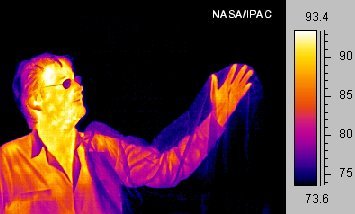
How does a thermal imaging camera work? A thermal imaging camera works by detecting infrared radiation and then processing it into an image that can be displayed on a screen.
Everything on Earth can absorb heat or radiate heat. Mammals, such as us, create our own heat by burning the food we eat to make energy. A byproduct of this process is heat. We need the heat to survive. Animals like crocodiles also need heat, but not as much as we do. They can get their heat from the sun, and they carry out all of their body processes much more slowly to conserve energy.
When something is heated, it gets more thermal energy. Thermal energy is the kinetic energy of the atoms of an object when they vibrate. Adding more thermal energy makes the atoms vibrate more, and this increases the temperature of the object. Thermal energy can only ever flow from an area of high energy to an area of low energy. This is the second law of thermodynamics. If the air around the object is cooler than the object itself, thermal energy will leave the object. This is why we get cold. We constantly lose our thermal energy to the air around us and we have to eat more food to replace the lost heat.
When thermal energy makes the atoms in a material vibrate, the charged particles inside them, the protons and electrons, accelerate. This acceleration creates oscillating electric and magnetic fields that travel in waves. The thermal energy gets carried away from the object along these electromagnetic waves in the form of photons. Everything above absolute zero has thermal energy and gives of electromagnetic waves. The thermal energy leaves our body into the air around us along these electromagnetic waves.
The amount of thermal energy the object possesses dictates the frequency of the electromagnetic wave that is produced. The frequency of wavelengths increases with the amount of energy. Very cold objects give off very long wavelengths, and as the object gets hotter, with more thermal energy, the wavelengths get shorter and shorter. The waves from extremely cold objects, such as the cosmic background, are radio waves. The waves from very cold objects are usually microwaves. The waves from things at about room temperature are infrared waves. The waves from slightly hotter things falls in the visible light spectrum. Then the waves from very hot things fall in the ultraviolet range. One thing does not only produce one type of radiation, but a range. For example, the sun gives off infrared radiation, visible light, and ultraviolet radiation.
Most of the things in the world we encounter every day fall in the heat range that produces infrared radiation, and this is what the thermal imaging cameras detect. We can’t see infrared light with our eyes, but there are sensors that can. A thermal imaging camera has a lens that focuses all of the infrared radiation onto something called a Focal Plane Array. A Focal Plane Array has a grid of infrared-sensitive elements that can generate an electric signal when they are hit by infrared radiation. In the same way the cones in our eyes do with visible light, the strength of the electrical signal depends on the amount of infrared radiation that hits each sensor. The computer in the thermal imaging camera takes these signals and translates them into an image, using different colors for the strength of the signal. Usually increasing reds up to white are hot and decreasing blues down to black are cold. This allows the camera to display a heat map of what it is seeing. If you are trying to find a person in a forest, most of the forest will be cold and dark, and the person will be hot, so they will be orange or red. There are different materials for detecting different infrared wavelengths. Indium antimonide is used for medium frequency wavelengths and amorphous silicon is used for longer wavelengths.
There are a lot of applications for thermal imaging cameras. Obviously, the one we are most familiar with is when the police use it to find people. They are also used by the rescue services to find people trapped in buildings and to see through smoke. They can be used in industry as well to see when parts are overheating. Power line maintenance technicians use them to analyze power lines and see if there are any hot spots, which are caused by a fault in the line. Architects and building engineers can use them to see where buildings are leaking heat and need to be improved. There are many other uses. This is what I learned today.
Sources
https://www.dwyeromega.com/en-us/resources/thermal-imagers
https://optris.com/lexicon/focal-plane-array
https://www.fluke.com/en/learn/blog/thermal-imaging/how-infrared-cameras-work
https://energyeducation.ca/encyclopedia/Infrared_radiation
https://en.wikipedia.org/wiki/Thermal_radiation
https://en.wikipedia.org/wiki/Thermography#Cameras
Image By NASA/IPAC – Transwiki approved by: w:en:User:Dmcdevit This image was copied from wikipedia:en. The original description was: This image comes from a NASA “Cool Cosmos” website: http://coolcosmos.ipac.caltech.edu/cosmic_kids/learn_ir/index.html Compare it to w:en:Image:Human-Infrared.jpg, Public Domain, https://commons.wikimedia.org/w/index.php?curid=2690179
